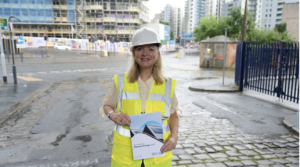The community finance revolution
 As a new pilot attempts to join up the dots of community finance, Clare Goff asks whether the time is ripe for an alternative finance revolution
As a new pilot attempts to join up the dots of community finance, Clare Goff asks whether the time is ripe for an alternative finance revolution
‘Money is round and it rolls away’, a wise person once said. In our local economies a lot of money is rolling away, into the pockets of payday lenders, large finance and big business. Doorstep lenders prey on the vulnerable, sucking them into a lifetime of debt; detached and distant banks refuse loans to small and new businesses; money rolls out of local areas, trapping places in a spiral of poverty and inertia.
But an alternative is brewing, a new finance that works at the neighbourhood level, joins up the dots in local economies and stops all that money from rolling away. It’s a local finance that includes ‘virtuous’ doorstep lenders, open local banks and local funding pots that circulate money around and within a local economy, making it work for the benefit of places.
The community finance revolution is taking a number of forms, but each model starts by placing people and local economies at its heart.
Uniting the elements of neighbourhood finance
In Bristol a pilot community banking partnership has begun to emerge. Boost Neighbourhood Finance is working in three of Bristol’s poorest wards to join up the various elements of local finance into a seamless whole. It will bring together a package of local financial services – services that are currently dispersed across different local organisations – from money management to personal banking, affordable credit and start-up loans, into one place.
The partnership is an initiative of the Community Development Finance Association (CDFA) and will be run locally by the South West Investment Group, a community development finance institution (CDFI).
Sarah Osborn, fund manager at SWIG explains. ‘Many people don’t see finance as something for them. They may have accessed debt advice but don’t come forward for business loans because they don’t think they have a flying chance. We will draw in all the services already available to help them. It’s not about a safety net but about providing a definite alternative.’
With funding from DCLG, it is hoping to offer a genuine alternative to those locked out of mainstream banking, to increase the level of disposable income in the area as well as the number of new businesses set up. The board will comprise local housing associations and the Barton Hill Settlement, which has worked in the area for over 100 years, as well as other local partners, and will knit together local needs with local provision available.
Sarah Osborn says: ‘We’re hoping to permeate groups and areas in ways that the existing separate services can’t and don’t’.
Two more community banking partnership pilots are set to launch in London and the CDFA’s chief executive Ben Hughes has a vision for community banking partnerships in every locality to improve access to finance and kickstart community economics.
‘It’s a great way of building from the bottom up, creating a new form of infrastructure. The Bristol pilot is the embryo of what will become more structured partnerships and more effective delivery of financial services to those currently denied access,’ he says.
Within these ‘community banking partnerships’ he envisions CDFIs merging with credit unions to offer both business and personal loans for example, and mainstream banks partnering with local finance organisations. He says that for such partnerships to work they need a joined-up watertight infrastructure, and a ‘compelling narrative’ about the power of local finance.
A compelling narrative for alternative finance
In Glasgow Scotcash provides a good example of how compelling that narrative can be. A community interest company, it sprang from the local council’s financial inclusion strategy in 2007 and brings together a wide range of local stakeholders from housing associations and the local council to debt advisors, the local credit union and mainstream banks such as RBS and Barclays.
Since its launch is has opened 500 basic bank accounts by allowing people without photographic ID to have an account; it has given debt advice to 4,500, helping prevent debt of £12.5m; there has been a 2% drop in banking exclusion; and £2.1m has been recycled into the local economy.
To chief executive Sharon Macpherson it makes no sense for the different elements of local finance to be separated. ‘Some people try to borrow their way out of debt. If someone approaches us to borrow we will provide them with the best advice about debt. Likewise if someone needs a loan because they are living in fuel poverty we can try to help them pay less for fuel so that they won’t need the loan in the first place.
‘Community finance needs to be a mixed economy provision. It doesn’t work if everyone tries to do it individually.’
Finance at the centre of a new public services
A more integrated local finance has been brewing for many years. In 2005 a Community Banking Partnership approach was developed across England and Wales. Seven pathfinders began operating, bringing together local players to develop an alternative local finance provision. The partnerships had some success, and many of them are still going. Fair Finance in east London integrates money advice, lending and credit union services and has a strong partnership with local housing associations. The Robert Owen community banking partnership in Montgomeryshire offers personal business and home improvement lending. These partnerships kicked off and inspired the development of more integrated local finance models.
But the difficulties of uniting local partners and a lack of capital and government support can make such community banking partnerships difficult to maintain. Competition in the sector makes it difficult for organisations such as credit unions and CDFIs to work together, and local integration is often difficult to pull off.
Its multi-agency response provides a glimpse of a
new model of integrated public services,
united by a local finance provider
Pat Conaty who set up the UK’s first CDFI – Aston Reinvestment Trust – back in 1997 says, ‘Local partnerships are not easy to build. It’s like building a house. There are lots of different kinds of people – the brickies, the electricians, the plumbers etc. All of those elements are needed for the building of the house but someone – the site manager – needs to play the role of controller and bring it all together.
‘Similarly community finance needs to be driven by a lead finance partner. This could be a CDFI or a credit union and in the US there are numerous group legal structures where the CDFI and the credit union are both co-driving the delivery.’
Scotcash works because it emerged out of the city’s financial inclusion strategy and is now its cornerstone. At Five Lamps, a community organisation that became a CDFI, local finance provision now sits at the centre of its broader service offer.
Set up following the closure of the local steelworks in the 1980s, Five Lamps ran employability programmes and offered enterprise advice for 20 years. Its only connection to local finance was signposting clients to their local credit union until a conversation led it down the path to becoming a CDFI, as chief executive Graeme Oram remembers.
‘We’d been working with one guy for a long time on employability programmes. He’d done every course under the sun and I said to him, “surely you should get a job now”. He replied, “I can’t feed my kids, I can’t sleep at night. There’s a threat of domestic violence at home. I owe thousands to doorstep lenders. Help me sort that out and I’ll think about getting a job”.’
The organisation became a CDFI in 2004 and Oram says that financial resilience – for both people and communities – unites all of what they do.
‘If people aren’t haemorrhaging money they are more likely to spend in a local business, they may decide to start a business, it impacts on their health and wellbeing and their ability to feed their kids, lessening the burden on the NHS later on.’
Its multi-agency response provides a glimpse of a new model of integrated public services, united by a local finance provider, where improving the ability of people to manage their finances and access funds acts as a springboard to a range of services that ultimately lead to a more resilient – and more financially stable – local economy. ‘There are no better opportunities than for CDFIs to bring together everything that’s needed in a local area, from literacy and employability programmes to enterprise and health, says Oram.
Local funding pots ‘recycle’ money
Wessex Resolutions takes the model a step further, creating local funding pots that are turned into loans and then recycled back into the local community. Set up to help vulnerable groups and rural communities locked out of mainstream finance in the south west of England, it obtained capital funding from twenty local authorities and used it to set up a home improvement loan scheme for those unable to access funds for housing maintenance. In what it describes as a ‘unique local funding mechanism’, loan repayments are recycled back into local authority pots to be re-lent again and again. It has added a free money advice service to its offer and the model could be used to fund any number of local services including social care loans.
UK dominated by ‘big finance’
For Pat Conaty and those that have been involved in community finance for many years, the seeds of a local finance model, such as those listed above, cannot come soon enough. He has been involved in Community Land Trust financing partnerships, which bring together finance partners around a community land trust scheme, and he envisions such local finance pots built into every area and used to fund a range of local services as well as renewable energy schemes and land partnerships.
The dots are starting to be joined in the UK, and the importance of placing local finance at the heart of local economies is beginning to be understood. But why has it taken so long for the UK to reach this point?
Since the demutualisation of local building societies in the 80s and 90s, local economies across the country have suffered from a lack of an alternative as mainstream finance here has become ever more distant from people and places.
But elsewhere in the world banks are proud of their connection to the people and places they serve. In the US the Community Reinvestment Act has obliged banks to provide banking products and facilities in low-income areas since the 1970s. A CDFI fund provides the capital, boosted by $400m by Obama as part of the stimulus bill. What began as a chore, is now a source of pride for many banks, which promote their long history of engagement and their community approach. In European countries like Italy and Germany a strong network of ‘stakeholder’ banks rooted in place has kept local finance flowing throughout the recession. A local bank in Italy has as its motto: ‘Attachment to territory is the best form of defence’.
For many the blame for the UK’s disconnection from local finance rests firmly with central government and its inability to see beyond big finance. As one commentator said: ‘The Treasury is describing and exploring domestic and community lending but is doing little to accelerate it. Until it lifts its long gaze from the City of London and starts focusing on the needs of people and communities, nothing will change’.
But something is brewing in local finance and investment. New local finance models are emerging to help money flow within local economies rather than roll out. New partnerships are joining up the dots. Some of the main political parties are looking for ways to unlock local capital. Could this be the time for local finance to unleash the capacity of local economies?


















